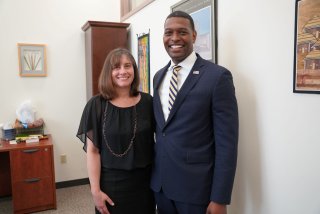Lifting Up and Phasing Down: A Service to America Medal Recipient’s Story
Before working at EPA, I had never heard the term hydrofluorocarbons (HFCs) and what I knew about the ozone layer and climate change came from the media. Years later, I have now spent the majority of my career helping to protect the ozone layer and fight these climate-damaging chemicals – and I am honored to receive a Service to America medal for my work.
To give you a little background on HFCs, these chemicals were originally developed as replacements for ozone-depleting substances (ODS). ODS are chemicals that destroy the earth’s protective ozone layer – and EPA began phasing these out under the Clean Air Act and the Montreal Protocol. HFCs are widely used in our everyday lives – they make our refrigerators cool, run our air conditioners, and are used in products ranging from asthma inhalers to foam furniture cushions. Unfortunately, these chemicals are hundreds to thousands of times more potent than carbon dioxide (CO2).
My first experiences at EPA involved setting up domestic regulations to stop the use of ozone-depleting substances (ODS) and to put us on a course to healing the ozone layer. Helping to build and implement those programs from the ground up taught me so much about how EPA and the federal government can work to protect people’s health and the environment.
Responding to Emerging Threats
I have been privileged to work not just domestically, but also with partners around the world under the Montreal Protocol. The Montreal Protocol has been called “perhaps the single most successful international environmental agreement,” by Kofi Annan, the former Secretary-General of the United Nations, and has been ratified by all the countries in the world. Since the Montreal Protocol’s inception in 1987, countries have worked together to eliminate the production and consumption of over 99% of ODS and have reduced emissions of these chemicals to our atmosphere, helping to protect the ozone layer and put it on a path to recovery by the middle of this century.
One of the hallmarks of EPA is realizing we can be nimble and respond to emerging threats. For example, in 2007 when countries agreed to accelerate the international phaseout of ODS, it became apparent we needed to re-examine the alternatives to ODS. Many of the alternatives were climate-damaging HFCs, and we did not want the legacy of successfully healing the ozone layer to be needlessly harmful to the climate system. As part of the U.S. delegation to the annual Montreal Protocol meetings, I heard firsthand from scientists about the damage HFCs were causing. It became apparent that something must be done to prevent increased emissions of these powerful greenhouse gases.
I’m incredibly proud of the work the U.S. and other countries did together to tackle HFCs. In 2016, after a seven-year effort that included negotiation sessions and meetings all around the world, we were able to agree to the Kigali Amendment to the Montreal Protocol that puts in place an international agreement to phase down HFCs (similar to what we did for ODS). We listened carefully to scientists, as well as the perspectives of industry and environmental groups, every step of the way. This global HFC phasedown is expected to avoid up to a half-degree Celsius of global warming by 2100.
Climate Protection at Home
That global agreement set the stage – but for EPA, the rubber hits the road with what we do at home. In the last days of 2020, Congress passed the American Innovation and Manufacturing (AIM) Act to address HFCs, and EPA has been hard at work to implement this law. We set up a phasedown to reduce the U.S. production and consumption of HFCs by 85% over the next 15 years. This rule is expected to avoid up to 0.5 °C of global warming by 2100.
Looking ahead, we will develop regulations on managing the use of HFCs and their substitutes in equipment to limit their emissions and increase the recycling and reuse of these chemicals. As extremely powerful greenhouse gases, HFCs accelerate climate change, which threatens society with costly health and environmental impacts such as floods, wildfires, drought, and increasingly severe weather events. Our approach to cap and phase down HFCs will better protect people and the planet.

I am incredibly humbled and honored to receive the 2022 Samuel J. Heyman Service to America Medal in Science, Environment, and Technology for my work on HFCs. This award is a wonderful way to acknowledge the hard work that federal employees do, day in and day out, and highlight some of our critical actions. People can make a huge impact working for the federal government, and I have always appreciated the opportunities and experiences I’ve had at EPA.
Working with colleagues to develop policy, provide technical analyses, and consider stakeholder perspectives makes my job endlessly fascinating. I’ve loved working at EPA and seeing everyone’s enthusiasm for their work and the pride we all take as we strive to protect the environment and improve public health. It’s a career like no other.
- Learn more about protecting our environment by reducing the use of HFCs.
- Read about the Samuel J. Heyman Service to America Medal.

About the Author
Cindy Newberg
Director of the Stratospheric Protection Division
EPA Office of Atmospheric Protection
Cindy Newberg is the Division Director of the Stratospheric Protection Division (SPD) in EPA’s Office of Atmospheric Protection. She was formerly the Chief of the Alternatives and Emissions Reduction Branch. She has helped represent the U.S. on delegations to the Montreal Protocol on Substances that Deplete the Ozone Layer since 2005. She holds an MPA from University of Maryland and a BA in International Relations from George Washington University’s Elliot School of International Affairs.
Editor’s Note: The views expressed here are intended to explain EPA policy. They do not change anyone’s rights or obligations. You may share this article. However, please do not change the title or the content, or remove EPA’s identity as the author. If you do make substantive changes, please do not attribute the edited title or content to EPA or the author.
EPA’s official web site is www.epa.gov. Some links on this page may redirect users from the EPA website to specific content on a non-EPA, third-party site. In doing so, EPA is directing you only to the specific content referenced at the time of publication, not to any other content that may appear on the same webpage or elsewhere on the third-party site, or be added at a later date.
EPA is providing this link for informational purposes only. EPA cannot attest to the accuracy of non-EPA information provided by any third-party sites or any other linked site. EPA does not endorse any non-government websites, companies, internet applications or any policies or information expressed therein.
